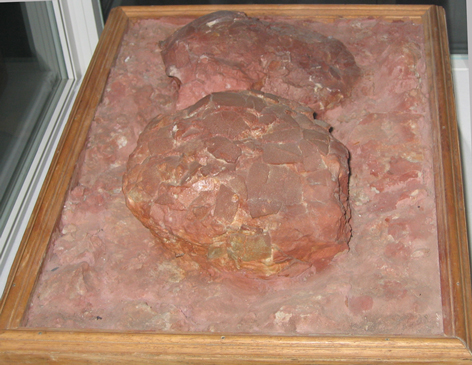“Treasure Trove” of Dinosaur Eggs found In India
Extensive Sauropod Nesting Site Unearthed in India
A team of Indian and German geologists found themselves “scrambling” for an explanation when they discovered evidence of an enormous sauropod nesting site in southern India. The team were working in the state of Tamil Nadu, searching for a suitable location from where they could excavate an ancient riverbed when they made this “eggciting” discovery. The site near the Sendurai village in the central district of Ariyalur may turn out to be the largest collection of dinosaur eggs ever found in the country. This region has provided many body fossils of dinosaurs from rock formations dating from across the Mesozoic era, but never before have so many dinosaur eggs been found in a single location on the Indian sub-continent.
Examples of Dinosaur Eggs (Probably Laid by a Titanosaur)
Picture credit: Everything Dinosaur
The site may be very significant in terms of research into the mass extinction event at the end of the Mesozoic. The Late Cretaceous nesting site, the team have revealed, may provide evidence on the environmental conditions at the time of extinction of the dinosaurs. The nesting site is estimated to cover at least one quarter of a mile and after an initial survey, the geologists dug deeper and discovered that fossilised eggs were deposited in layers indicating that this particular location was used year after year.
Commenting on their amazing find Dr Ramkumar, Geology lecturer at Periyer University stated:
“We found clusters and clusters of spherical eggs of dinosaurs, and each cluster contained eight eggs” .
The eggs measure 13 to 20 centimetres in diameter and they were lying in sandy nests about 1.2 metres wide. Scientists believe that these spherical eggs were laid by a type of long-necked, elephantine dinosaur of the sub-order Sauropoda. It is most likely, given the age of the fossils that they were laid by some type of titanosaur. The researchers estimate that there are literally hundreds of nests however, the eggs studied so far never hatched, for some reason either the animals that laid them were infertile or the embryos inside died.
Sauropod Nesting Site
Similar nesting sites of titanosaurs are known from South America. In 1997, a large titanosaur nesting site was unearthed in Patagonia (Southern Argentina). The eggs were laid in shallow depressions, excavated out of the sandy soil and from the location of the many nests it seems that herbivorous sauropod dinosaurs used the same favourite nesting site year after year. The nests contained many broken shells and it is believed that most of these particular dinosaurs hatched successfully. The nesting sites have been associated with the medium-sized titanosaur Saltasaurus. On average there were more than eight eggs in each of the South American nests, so based on this evidence either saltasaurs laid more eggs than the species concerned with the Indian nest site, or perhaps strain on the species was causing the Indian sauropods to lay fewer eggs.
There are some unhatched sauropod nests associated with the South American site. These seem to have been affected by rising water levels and a rising water table which drowned the young dinosaurs in their eggs.
To view a models of sauropods and other types of long-necked prehistoric animal: Dinosaur and Prehistoric Animal Models.
Dr Ramkumar went onto state:
“The important finding is that these eggs have been found in different layers that means the dinosaurs came to the place over and over year after year. The second important thing is that we have got volcanic ash deposits on the eggs which suggests that volcanic activity could have caused their extinction.
The Deccan Traps were releasing vast amounts of volcanic ash and other noxious substances into the environment during this time in the Late Cretaceous. Many scientists believe that climate change caused by these volcanic activity may have been a factor in the mass extinction event that occurred approximately 66 million years ago. Now this infertile nesting site could provide direct evidence as to the ecological disaster facing life on Earth at the time.
To read a previous article on the Deccan Traps: Blame the Deccan Traps.
“The other thing we have found is that all these eggs are unhatched and infertile. So what made the eggs infertile? We need to carry out further studies to learn more from the findings”.
Dr Ramkumar commented.
Fossilised Eggs
Fossilised eggs have been found in the region previously, there is a report from a British scientific expedition in the 1860s when India was part of the British Empire, but this site may yield information on the environment at the time of the demise of the dinosaurs as well as providing insight into titanosaur nesting behaviour.
Interestingly, if plant-eating dinosaurs returned year after year to the same traditional nesting grounds and for some reason these areas become unsuitable for nesting and the survival of eggs, then the eggs laid in that area are not likely to survive. Could this be a reason for dinosaur extinction? Ingrained and instinctive behaviours at a time of dramatic climatic upheaval caused the death of whole nesting colonies for years. Perhaps dinosaurs could not change their nesting habits and this led to a collapse in the population of dinosaurs, with no offspring being produced to replace those older animals that died. Also, the relatively low numbers of eggs per site (8), could this be significant? Were dinosaurs producing fewer and fewer young as a result of environmental change?
Samples of the eggs are to be sent to Germany for further research in a bid to try to answer some of these intriguing questions.


